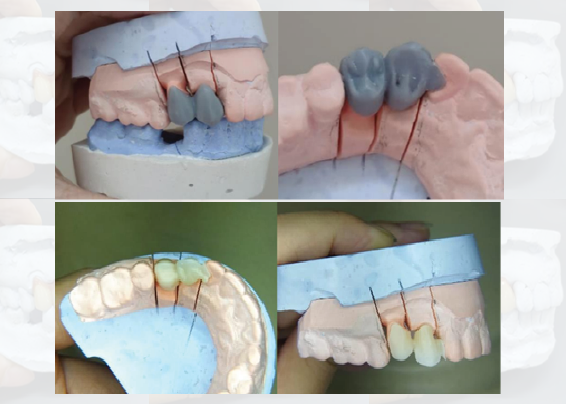FABRICATION OF ALL PORCELAIN CANTILEVER BRIDGE RESTORATION IN CASES OF GINGIVA RECESSION USING ZIRCONIUM DIOXIDE MATERIAL WITH ADDITIONAL RETENSION

Downloads
Background: Aesthetic and functional dental restoration is a hope for people who have lost teeth, especially in the anterior region. Missing tooth 13 with more than 2 mm gingival recession can be made into a cantilever bridge restoration with the addition of porcelain gingiva. Gingival recession is when the tooth root surface is exposed due to periodontal tissue loss. Zirconia is a dental restoration material often used because of its biocompatibility, strength, and aesthetics. Purpose: To determine the procedure for making all porcelain cantilever bridge restorations in cases of gingival recession using zirconia material. Case analysis: The dental laboratory received a dental cast model of a 39-year-old female patient missing tooth 13 and had gingival recession on tooth 14 of more than 2 mm. Order in the form of restoration of all porcelain cantilever bridges from zirconia. Result: The cantilever bridge coping was made from zirconium dioxide and then layered with feldspathic porcelain to achieve optimal strength and aesthetics. A rest is made on tooth 12 to provide additional retention. Conclusion: The procedure for making all porcelain cantilever bridge restorations includes making diagnostic wax-up, scanning, coping design, milling, sintering, fitting, sandblasting, layering, anatomy, and glazing. Things that must be considered are the design, thickness of the coping, and connectors to achieve a restoration that is strong, resistant to fracture, and has good aesthetics. Porcelain gingiva was added in the cervical area of tooth 14 restorations to cover the recession
Alex, G., 2021. Keys to Successful Placement of Zirconia Restorations. Compendium Vol. 42(3).
Amudhalakshmi, K., Sethalakhsmi, A., Biswas, K.P., 2016. A Review of CAD CAM in Dentistry. Journal of Indira Gandhi Institute of Medical Science Vol. 2(2), Pp. 16-21.
Ban, S., 2021. Classification and Properties of Dental Zirconia as Implant Fixtures and Superstructures. Materials (Basel) Vol. 14(17), Pp. 4879.
Bapat, R.A., Yang, H.J., Chaubal, T.V., Dharmadhikari, S., Abdulla, A.M., Arora, S., Rawal, S., Kesharwani, P., 2022. Review on Synthesis Properties and Multifarious Therapeutic Applications of Nanostructured Zirconia in Dentistry. RSC Adv. Vol. 12(20), Pp. 12773-12793.
Brooks, B., Rolland, D., 2015. Wet or Dry? The Need for Both Dental Milling Machines.
Daou, E.E., 2014. The Zirconia Ceramic: Strengths and Weaknesses. Open Dent J Vol. 8, Pp. 33-42.
De Matos, J.D.M., Lopes, G.R.S., Queiroz, D.A., Nakano, L.J.N., Ribeiro, N.C.R., Barbosa, A.B., Anami, L.C., Bottino, M.A., 2022. Dental Ceramics: Fabrication Methods and Aesthetic Characterization. Coatings Vol. 12(8), Pp. 1228.
Della Bona, A., Pecho, O., Alessandretti, R., 2015. Zirconia as A Dental Biomaterial. Materials Vol. 8(8), Pp. 4978-4991.
ESPE, 2013. Clinically Successful with LavaTM Zirconia Restorations. Germany.
Federizzi, L., Gomes, É.A., Báratro, S.S.P., Baratto-Filho, F., Bacchi, A., Spazzin, A.O., 2016. Use of Feldspathic Porcelain Veneers to Improve Smile Harmony: A 3-Year Follow-up Report. Braz Dent J Vol. 27(6), Pp. 767-774.
Ferrari, J.O., Dalitz, F., Baechtold, M., Gaiao, U., Cunha, L., Gonzaga, C., Correr, G., 2017. Esthetic Rehabilitation of Anterior Teeth Through Gingival Recontouring and Ceramic Veneers: A Case Report. RSBO Vol. 13(4), Pp. 275.
Gargari, M., Ottria, L., Morelli, V., Benli, M., Ceruso, F.M., 2015. Conservative Zirconia-Ceramic Bridge in Front Teeth. Case Report Vol. 7, Pp. 93-98.
Ha, S.-R., Kim, S.-H., Lee, J.-B., Han, J.-S., Yeo, I.-S., Yoo, S.-H., 2016. Effects of Coping Designs on Stress Distributions in Zirconia Crowns: Finite Element Analysis. Ceramics International Vol. 42(4), Pp. 4932-4940.
Joós-Kovács, G., Vecsei, B., Körmendi, Sz., Gyarmathy, V.A., Borbély, J., Hermann, P., 2019. Trueness of CAD/CAM Digitization with A Desktop Scanner An in Vitro Study. BMC Oral Health Vol. 19(1), Pp. 280.
Juntavee, N., Attashu, S., 2018. Effect of Different Sintering Process on Flexural Strength of Translucency Monolithic Zirconia. Journal of Clinical and Experimental Dentistry Vol. 10(8), Pp. e821-e830.
Karami Zarandi, P., Madani, A., Bagheri, H., Moslemion, M., 2020. The Effect of Sandblasting and Coating of Zirconia by Nano Composites on Bond Strength of Zirconia to Resin Cements. J Dent (Shiraz) Vol. 21(1), Pp. 63-68.
Kern, M., Passia, N., Sasse, M., Yazig, C., 2017. Ten-Year Outcome of Zirconia Ceramic Cantilever Resin-Bonded Fixed Dental Prostheses and The Influence of The Reasons for Missing Incisors. Journal of Dentistry Vol. 65, Pp. 51-55.
Krismariono, A., 2014. Prinsip Dasar Perawatan Resesi Gingiva (Basic Principle in the Treatment of Gingival Recession). Dentika Dental Journal Vol. 18(2014), Pp. 96-100.
Madfa, A., Al-Sanabani, F., Al-Qudami, N., Al-Sanabani, J., Amran, A., 2014. Use of Zirconia in Dentistry: An Overview. The Open Biomaterials Journal Vol. 5, Pp. 1-9.
Mostafa, D., Fatima, N., 2022. Gingival Recession and Root Coverage Up to Date, A literature Review. Dentistry Review Vol. 2(1), Pp. 100008.
Naik, N.R., Motwani, B.K., Shailendra Kumar Sahu, Singh, S., Dani, A., Kulkarni, S., 2015. “Gingival Porcelain”: Successful Restoration of Lost Smile. International Organization of Scientific Research (IOSR) Vol. 14(3), Pp. 18-20.
Nistor, L., Grădinaru, M., Rîcă, R., Mărășescu, P., Stan, M., Manolea, H., Ionescu, A., Moraru, I., 2019. Zirconia Use in Dentistry - Manufacturing and Properties. Current Health Sciences Journal Vol. 45(1), Pp. 28-35.
Sharma, A., Rahul, G.R., Poduval, S.T., Shetty, K., 2012. Assessment of Various Factors for Feasibility of Fixed Cantilever Bridge: A Review Study. International Scholarly Research Notices Vol. 2012, Pp. e259891.
Singh, R.G., Li, K.C., Lyons, K.M., Waddell, J.N., 2021. Effect of Two Brands of Glaze Material on the Flexural Strength and Probability of Failure of High Translucent Monolithic Zirconia. Materials Vol. 14(22), Pp. 7022.
Su, N., Yue, L., Liao, Y., Liu, W., Zhang, H., Li, X., Wang, H., Shen, J., 2015. Effect of Various Sandblasting Conditions on Surface Changes of Dental Zirconia and Shear Bond Strength between Zirconia Core and Indirect Composite Resin. Journal of Advanced Prosthodontics Vol. 7(3), Pp. 214-223.
Tanweer, N., Qazi, F.-U.-R., Das, G., Bilgrami, A., Basha, S., Ahmed, N., Bahammam, H.A., Bahammam, S.A., Basheer, S.N., Assiry, A.A., Karobari, M.I., Khan, A.S., Heboyan, A., 2022. Effect of Erosive Agents on Surface Characteristics of Nano-Fluorapatite Ceramic: an In-Vitro Study. Molecules Vol. 27(15), Pp. 4691.
Toma, F.R., Porojan, S.D., Vasiliu, R.D., Porojan, L., 2023. The Effect of Polishing, Glazing, and Aging on Optical Characteristics of Multi-Layered Dental Zirconia with Different Degrees of Translucency. Journal of Functional Biomaterials Vol. 14(2), Pp. 68.
Weigl, P., Sander, A., Wu, Y., Felber, R., Lauer, H.-C., Rosentritt, M., 2018. In-Vitro Performance and Fracture Strength of Thin Monolithic Zirconia Crowns. Journal of Advanced Prosthodontics Vol. 10(2), Pp. 79-84.
Copyright (c) 2024 Journal of Vocational Health Studies

This work is licensed under a Creative Commons Attribution-NonCommercial-ShareAlike 4.0 International License.
- The authors agree to transfer the transfer copyright of the article to the Journal of Vocational Health Studies (JVHS) effective if and when the paper is accepted for publication.
- Legal formal aspect of journal publication accessibility refers to Creative Commons Attribution-NonCommercial-ShareAlike (CC BY-NC-SA), implies that publication can be used for non-commercial purposes in its original form.
- Every publications (printed/electronic) are open access for educational purposes, research, and library. Other that the aims mentioned above, editorial board is not responsible for copyright violation.
Journal of Vocational Health Studies is licensed under a Creative Commons Attribution-NonCommercial-ShareAlike 4.0 International License
















































